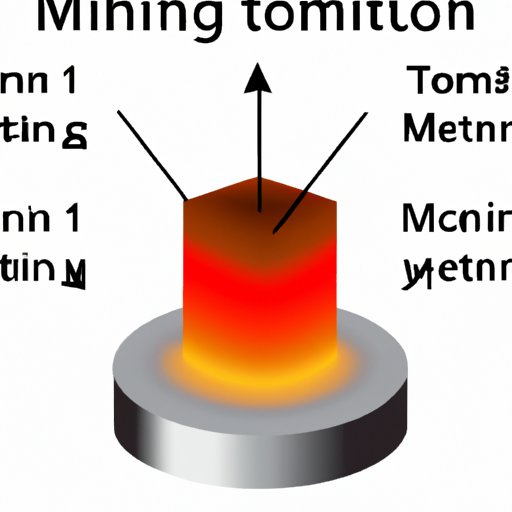Introduction
When it comes to choosing a metal for high-temperature applications, one of the most important factors is the metal’s melting point. The higher the melting point, the more heat the metal can withstand before it starts to melt. In this article, we’ll explore which metal has the highest melting point and what makes it ideal for use in extreme temperatures.
Exploring the Physical Properties of Metals: Which Metal Can Withstand the Highest Temperatures?
Melting point is defined as the temperature at which a solid substance becomes a liquid. For metals, this is an important property to consider in high-temperature applications because it determines the temperature at which the metal will start to deform or melt. Metals are known for their high melting points, which is due to their chemical and physical properties.
One of the unique properties of metals is their strong metallic bonding, which is responsible for their high melting points. Metallic bonding occurs when metal atoms share electrons and form a lattice structure. This strong bond holds metal atoms together even at high temperatures, preventing them from breaking apart and melting.
Alloying is another way to increase the melting point of metals. By combining two or more metals, an alloy is created with new physical and chemical properties. Alloying can increase the melting point of metals and improve their resistance to corrosion, wear, and deformation.
The Ultimate Heat Test: Which Metal Holds the Record for the Highest Melting Point?
Tungsten holds the record for the metal with the highest melting point, at 3,422 °C (6,192 °F). Tungsten is a rare metal that is known for its dense, heavy properties and high resistance to heat and wear. Its unique properties make it ideal for use in high-temperature applications, such as in light bulb filaments, welding electrodes, and furnace components.
Tungsten was discovered in 1781 by Swedish chemist Carl Wilhelm Scheele, and it wasn’t until the early 20th century that it became widely used in industrial applications. Today, tungsten is used in a variety of high-temperature applications because of its unique combination of physical and chemical properties.
Pushing the Limits: A Comparison of Different Metals and Their Ability to Withstand Extreme Temperatures
While tungsten has the highest melting point of any pure metal, there are other metals and alloys that can withstand high temperatures as well. For example, rhenium has a melting point of 3,180°C (5,760 °F) and is often alloyed with tungsten to improve its high-temperature properties.
Other metals and alloys with high melting points include molybdenum, tantalum, and niobium. Each metal and alloy has its unique properties, pros, and cons for high-temperature applications. Molybdenum, for example, is known for its strength and resistance to corrosion and is often used in furnace parts, electrodes, and missiles. Tantalum is another rare metal that is known for its high corrosion resistance and is often used in chemical processing equipment and capacitors.
The Science of Melting Points: Which Metal Will Melt Your Mind with its Temperature-Resistant Properties?
The melting point of a metal is determined by the strength of the metallic bond between atoms. The stronger the bond, the higher the melting point. The atomic structure of a metal, its crystal lattice, and electron configuration all affect melting point. Metals with a large number of valence electrons, such as tungsten, have a stronger metallic bond and higher melting point.
The way in which metal atoms are arranged within the lattice structure also influences the melting point. The more closely packed the atoms, the higher the melting point, as this creates a stronger metallic bond. Science has shown us that a metal’s melting point is intricately tied to its atomic structure and bonding characteristics.
Breaking Down the Heat Barrier: A Guide to Understanding Which Metal is the Best for High-Temperature Applications
In conclusion, for high-temperature applications require materials that can withstand extreme heat. Different metals and alloys have different melting points, properties, pros, and cons. Tungsten is known for having the highest melting point of any pure metal. Other metals and alloys with high melting points include rhenium, molybdenum, tantalum, and niobium, each with their unique properties and uses.
When choosing a metal for high-temperature applications, it is essential to consider the specific needs of the application, such as temperature, pressure, and environment. It is also important to follow safety protocols and guidelines when working with high-temperature metals to prevent accidents and injuries.
From Copper to Tungsten: A Journey Through Metals and Their Melting Points
Here is a list of common metals and their approximate melting points, from lowest to highest.
- Copper – 1,085°C (1,985°F)
- Aluminum – 660°C (1,220°F)
- Carbon steel – 1,377°C (2,510°F)
- Nickel – 1,455°C (2,651°F)
- Titanium – 1,668°C (3,034°F)
- Molybdenum – 2,623°C (4,753°F)
- Tantalum – 2,996°C (5,425°F)
- Niobium – 2,477°C (4,491°F)
- Tungsten – 3,422°C (6,192°F)
Now that you know which metal has the highest melting point and how different metals and alloys compare, you can make an informed decision about the best material to use in your high-temperature application.
